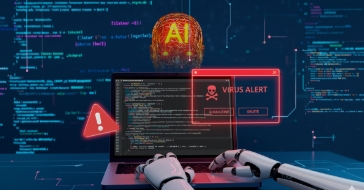
Artificial Intelligence (AI) has completely transformed the process of developing software. From auto-generating code snippets to optimizing testing pipelines, AI helps in every phase of SDLC. For many teams, using AI in software development feels like having an extra team member who never sleeps. But with this surge of innovation comes new challenges.
In fact, a recent study by Joe Spracklen highlights how LLMs mostly generate insecure code and even “hallucinate” packages that don’t exist. These findings make it clear that while AI promises innovation, businesses cannot ignore the risks of using AI in software development.
For every entrepreneur racing to adopt AI tools to beat competitors, the question isn’t whether to use AI, but how to use it responsibly and correctly. This article shows you a mirror of the biggest risks you need to know, real-world examples that prove the stakes, and practical ways to balance speed with security.
How Did AI Rise in Software Development?
AI has moved so far from being just a futuristic concept; it’s become a daily coding companion in just a few years. What started as basic code completion tools has now evolved into powerful assistants such as GitHub Copilot, ChatGPT, Tabnine, and Replit Ghostwriter. These tools can write functions, fix bugs, and generate entire modules by unlocking AI’s power for software development.
The promise is very clear with AI adoption: faster prototyping, fewer repetitive tasks, and more time for developers to focus on strategy building and innovation.
But this adoption has been faster than careful evaluation. Many entrepreneurs are rushing to embed AI into their business workflows without thinking about consequences. While the AI benefits are undeniable, the risks like insecure code and hidden biases are just as real.
To truly understand and leverage the best from the future of development, you need to look beyond the hype and tackle the risks head-on.
What Are the Key Risks of Using AI in Software Development?
Implementing AI in the software development process is about speeding up coding and testing, but it isn’t foolproof. From insecure outputs to licensing headaches, organizations that adopt AI have faced multiple risks that demand consistent human oversight and governance. Let’s learn key risks and challenges of AI and what is necessary to mitigate risks of using AI tools.
1. Code Quality and Reliability Risks
Generating a code with AI can be buggy, insecure, or poorly optimized. Heavily relying on AI tools may also reduce developers’ critical thinking, problem-solving ability, and leading to missed edge cases or hallucinated APIs that don’t even exist.
AI models are powerful, but still lack deep contextual understanding of a project’s architecture. They may generate code for functions that look correct syntactically but fail under real-world scenarios. Ultimately, this creates a false sense of reliability, especially for less experienced or learning developers.
| Solution: Keep practicing, maintaining a human-in-the-loop approach. All AI-generated code should undergo review first before using it for launch. A peer review, static analysis, and unit testing are a must from humans for AI-based code. Developers should treat AI outputs as drafts, not final production-ready code. |
2. Security and Data Privacy Concerns
AI tools may unintentionally leak sensitive data while training or generating code for software development. Also, it embeds vulnerabilities that compromise compliance with security and privacy standards like GDPR, HIPAA, or SOC 2.
For instance, some AI assistants have cached or transmitted snippets of proprietary code to any external servers. This creates risks of using AI in software development by data leakage, especially if the system processes healthcare, finance, or government data.
On the other side, the code generated by this AI assistant may contain subtle vulnerabilities such as SQL injections, hardcoded secrets, or weak encryptions that may remain unnoticed until exploited. A CSET report noted that insecure code generated by AI can propagate cybersecurity risks across the ecosystem.
| Solution: Don’t underestimate complying with strict data governance. Prioritize using on-premises or private LLMs for sensitive industries. Plan to conduct regular security audits, tech due diligence, and adopt a “trust but verify” approach to AI outputs before the final product launch. |
3. Intellectual Property and Licensing Risks
If we talk about ownership of AI-generated code, then you should know it’s still a gray area in the software development process. As many LLMs are trained on open-source projects with unclear or restrictive licenses, enterprises are risking legal and compliance challenges by adopting such outputs.
Key Risks to Consider:
- Copyright Ambiguity: There is no clear proof or general agreement on whether AI-generated code is legally protected.
- Open-source Conflicts: The most probable cause of code snippet inclusion in AI outputs is restrictive licenses.
- Legal Exposure: Enterprises are at risk of lawsuits if AI-generated code directly or indirectly violates the IP rights.
- Costly Rewrites: If any kind of violation is found, then redevelopment can be highly expensive for any organization.
| Solution: Without doing any delay or postponement, establish a clear licensing policy for AI-assisted development. Developers should document where AI was used, avoid blindly copy-pasting, and involve legal teams to review compliance before commercialization of the product. |
4. Integration and Compatibility Issues
AI-generated code mostly works when you run it separately, but it can fail when integrated with existing systems. Legacy systems, custom frameworks, or complex databases can clash with AI outputs, creating errors or downtime.
Even minor mismatches or mistakes like inconsistent function names, incompatible data types, or unexpected API calls can become the reason for larger problems. Big organizations are especially vulnerable because fixing integration issues in enterprise-scale systems is time-consuming and costly.
| Solution: Leverage the top AI-powered software development services to ensure perfect AI integrations throughout the system. Make sure the firm you hire has the practice to test integration thoroughly and maintain expert oversight for critical systems. If you don’t want to risk your enterprise-level system, then collaborating with experts is the best solution ever. |
5. Bias and Ethical Concerns in AI Models
AI learns what you want it to teach. All the AI tools learn from large datasets, and if those datasets are biased, then AI can learn that biased thing and produce unfair outputs. This can be a serious problem, especially in software that makes decisions that affect people, like hiring tools, healthcare apps, or loan approvals.
For example, if the AI-powered training data underrepresents certain groups, AI-generated recommendations or code could unintentionally favor one group over another, which is completely unethical.
Blindly trusting AI results, unchecked bias can damage user trust, create legal risks, and lead to ethical controversies. Developers must stay responsible for AI outputs, ensuring that human oversight and verification validate decisions and test results for fairness.
| Solution: Make sure you regularly audit AI outputs using different datasets. Implement fairness checks on a compulsory basis, and create review processes to catch biased or discriminatory outputs before they reach production. |
6. Dependency and Skill Degradation
Highly relying on AI can make developers less capable of problem-solving on their own. Teams that use AI tools and technology for every coding task risk losing critical skills in debugging, architecture design, and manual coding.
As time passes, this creates an AI skills gap, where developers may struggle to work effectively without the help of artificial intelligence. Startups and enterprises could find it challenging to hire or train talent who understand both traditional software development and AI-assisted workflows.
Ultimately, this over-dependence causes reduced creativity, as developers may default to AI suggestions without questioning whether they are optimal or correct. Without proper skill development, teams may face long-term operational risks and a slow process of innovation.
| Solution: Always remember to treat AI as a support tool, not a replacement. AI is here to assist, not replace. Encourage manual coding exercises, code review on a mandatory basis, and rotating between AI-assisted and traditional tasks to keep skills and capabilities sharp. |
7. Cost and Hidden Resource Risks
AI adoption may look like an affordable option, but without proper research and considering priority requirements, tool selection comes with hidden costs. These include high API usage, model retraining, compliance audits, and patching insecure or incompatible code. Many companies don’t take these expenses seriously, thinking AI will automatically reduce the software development costs.
Key Hidden Costs:
- API usage or subscription fees that increase as you add more features.
- Retraining AI models to adapt to your project context properly.
- Compliance checks and audits for legal and data security standards.
- Fixing AI-generated code that contains errors or vulnerabilities on a consistent basis.
| Solution: Start with small pilot projects to measure the real software development costs. Must consider licensing, security, and compliance in your planning. Expand AI use only when the AI risks and benefits clearly outweigh the hidden costs. |
What Are the Real-World Examples of AI Risks in Software Development?
The risks of using AI in software development are not a hypothetical concept. From lawsuits to insecure outputs, there are many real-world incidents that highlight why developers and businesses must stay secure when adopting such AI tools and technology.
Notable Cases:
- GitHub Copilot Lawsuit: Developers filed a class-action lawsuit claiming that Copilot reproduced the licensed open-source code without any attribution. It raises questions about copyright ownership and compliance.
- Developer Anecdotes: Many coders have reported that AI-suggested codes are outdated functions, missing logic, or even non-existent APIs. These can cause delays, errors, and costly debugging in production.
These real stories serve as reminders that while AI absolutely speeds up coding, the unchecked adoption can bring legal, security, and operational AI risks.
Final Thoughts
AI is undoubtedly a powerful trend that is reshaping the way any software is designed, coded, and deployed. But the risks of using AI in software development are real.
From insecure code and licensing issues to hidden costs, there are many AI risks that show why unchecked adoption can be dangerous. Ignoring human oversight and clear safeguards, the AI promises can quickly turn into hard setbacks.
For startups and enterprises, considering risk-aware adoption is the best way. Use AI for efficiency, but don’t forget to pair it with strong governance, regular audits, and continuous developer training.
If you are exploring AI for your software development workflows, consider seeking expert guidance to maximize the benefits while reducing potential AI risks.


